The family Nepticulidae hold some of the smallest moths known, ranging from 3-8mm wing-tip to wing-tip. For a comparison I have imaged two moths above: the largest known – Coscinocera hercules that tips the scales at nearly 9 inches, and one of the smallest (yes that tiny little speck below the Hercules moth) – Ectoedemia rubifoliella, also imaged below. The Nepticulidae are surprisingly diverse, מיט איבער 800 species described that likely represent only 10% of the actual diversity (Powell, 2009). In the United States we have only 80 זגאַל, of which 25 are known from the west. When you compare that diversity to the 100 or so species known from Great Britain, it’s clear that the US knowledge is vastly lacking. פאקטיש, over 80% of all nepticulid diversity is known from Europe alone. א מאָדנע ינווערזשאַן ווען איר באַטראַכטן אַז די נעאָטראָפּיקס זענען די וועלט 'ס מערסט דייווערס יקאָוסיסטאַמז נאָך האָבן בלויז 74 באקאנט Nepticulidae מינים! (פּופּלעסיס, 2000). פארוואס איז דאָס אַזוי?
 Stigmella ostryaefoliella 3.1OR
Stigmella ostryaefoliella 3.1OR
די אייראפעישע דייווערסיטי קענען לייכט זיין דערקלערט אַוועק רעכט צו אַ הויך קאַנסאַנטריישאַן פון באָרד לעפּידאָפּטעריסץ. די האָלאַרקטיק פאָנאַ איז נישט די מערסט דייווערס און איז דערפֿאַר דער בעסטער פארשטאנען אויף דעם פּלאַנעט, ניט צו דערמאָנען זיי האָבן געהאט אַ לאַנג געשיכטע פון דזשענטלמען ענטאָמאָלאָגיסץ דייטינג צוריק הונדערטער פון יאָרן. אבער די רעשט פון די דייווערסיטי פון די Nepticulidae בלייבט אַ מיסטעריע ווייַל זיי זענען טאַקע, טאַקע קליין, שווער צו פאַרשפּרייטן, און שווער צו ידענטיפיצירן ווי אַדאַלץ! איך האָבן אַקשלי געהאט קליין פיר אָדער הצלחה מיט מאַונטינג Nepticulidae, and the above specimens should be credited to Dr. דייוו וואַגנער. The very few that I do have in my collection are simply pinned and un-spread; and even the pinning proves hard enough when a slip of the hand can obliterate the entire specimen. Apparently the best method for mounting is to knock them down in the freezer and pin them while they are still alive. Not the most humane, but the only way to keep the moth from drying before your eyes and becoming impossible to manipulate. As hard as the adults are to manage, the larvae are rather characteristic in that most are leaf miners – they feed on the material צווישן the leaf epidermises. This lends to the common name of “leaf blotch miners” because you can see the translucent patches the moths have ‘mined’ out from inside the leaf. ניט בלויז איז יעדער מינים גאַנץ באַלעבאָס-ספּעציפיש, אָבער זיי טענד צו פאָרעם זייער כאַראַקטעריסטיש מייַן פּאַטערנז אין דעם בלאַט. אַזוי אויב איר געפֿינען אַ בלאַט מייַן און איר וויסן די מינים פון פאַבריק, גיכער זענען איר קענען געפֿינען די מינים פון נעפּטיקוליד אין עס (אָבער ניט אַלע בלאַט מינעס זענען נעפּטיקולידס, עס זענען פילע אנדערע ינסעקץ וואָס טאָן דאָס אויך). רירינג די מאָטס זענען אויך גאַנץ פּשוט, אַלע איר האָבן צו טאָן איז שטעלן די בלאַט אין אַ זעקל און וואַרטן פֿאַר די מאָל צו ענדיקן פידינג. איין רויפּע דאַרף נאָר איין בלאַט (אָדער קליינטשיק אָפּטיילונג פון בלאַט) – אָבער מען דאַרף זאָרגן צו האַלטן די בלאַט גרין בשעת די רויפּע פידז. אויב די בלאַט שטאַרבן, אַזוי וועט דער רויפּע. Because of this paradoxical ability to identify the mines and not the adults there is a surprising amount of ecological research done on them, especially since a few pose threats to commercial crops. The first image below clearly illustrates the caterpillar feeding within the leaf – and the trail of frass it has left behind.
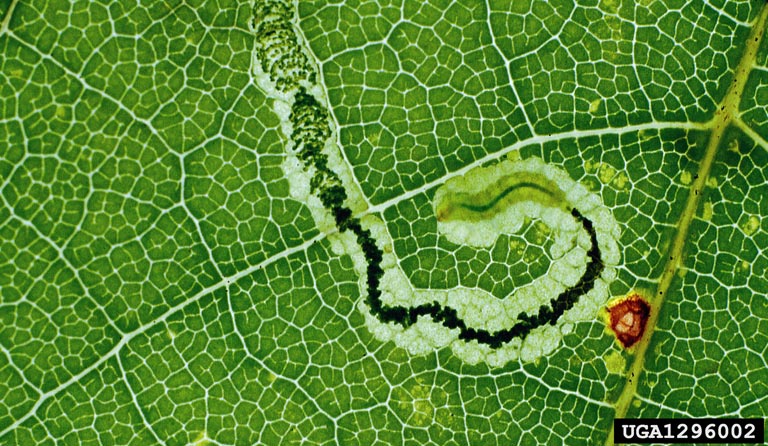 Stigmella aceris (link to image credit)
Stigmella aceris (link to image credit)
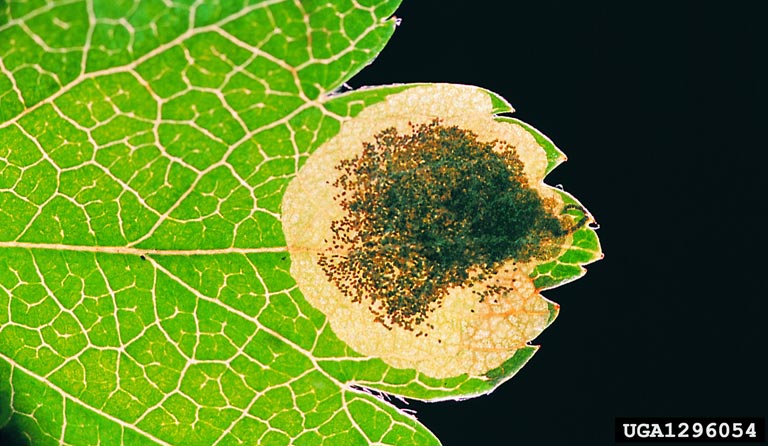 Stigmella paradoxa (link to image credit)
Stigmella paradoxa (link to image credit)
If you look at the above images of mines it’s not all that difficult to imagine structures like this fossilizing. And amazingly, they have! The first image below (Labandeira et al., 1994) shows a variety of leaf mining Nepticulidae mines (and a Gracillariidae) from the mid-Cretaceous (97 מיליאָן יאר צוריק). The spectacular thing about leaf mines is that you can get down to genus level and sometimes even species. די מחברים זענען ביכולת צו דיפערענטשיייט צווישן די נעפּטיקוליד גענעראַ סטיג מעלאַ און עקטאָדעמיאַ באזירט אויף די פּאַטערנז אפגעהיט אין די פאַסאַלז; פּאַטערנז וואָס מיר נאָך נוצן צו העלפן באַזונדער גענעראַ הייַנט. די דנאָ געמעל איז פֿון אַ מייַן דיסקאַווערד אין יאַפּאַן וואָס איז בלויז אַרום 8 מיליאָן יאר אַלט (Kuroko, 1987).
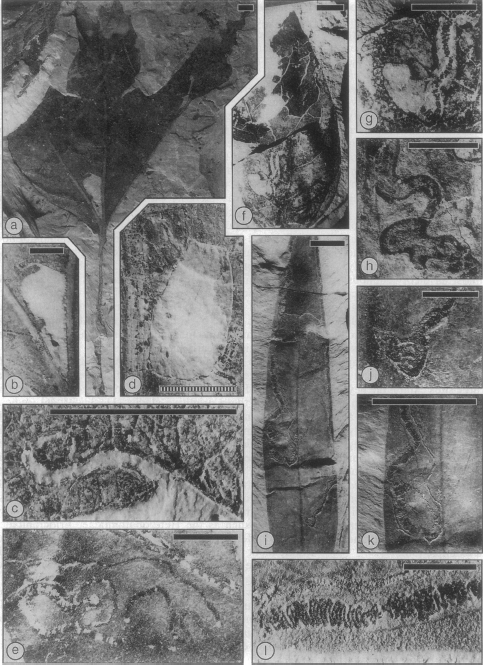 (וועש, 1994)
(וועש, 1994)
באַווייַזן
Kuroko, ה. (1987). א פאָססיל בלאַט מייַן פון Nepticulidae (לעפּידאָפּטעראַ) פון יאַפּאַן. Bulletin Sugadaira Montane Res. Cen., No.8, 119-121.
Labandeira, C. (1994). זיבן און ניינציק מיליאָן יאָרן פון אַגיאָספּערם-ינסעקט אַססאָסיאַטיאָן: פּאַלעאָביאָלאָגיקאַל ינסייץ אין די טייַטש פון קאָעוואַלושאַן פאַרהאַנדלונג פון די נאַשאַנאַל אַקאַדעמי פון ססיענסעס, 91 (25), 12278-12282 דאָי: 10.1073/pnas.91.25.12278
פּופּלעסיס, ר., DIŠKUS, א., ROBINSON, ג., & האָנאָור, ג. (2002). א רעצענזיע און טשעקליסט פון די נעאָטראָפּיקאַל נעפּטיקולידאַע (לעפּידאָפּטעראַ) בוללעטין פון די נאַטוראַל געשיכטע מוזיי. ענטאָמאָלאָגי סעריע, 71 (01) דאָי: 10.1017/S0968045402000032
Powell, י.א., אָפּלער, פּ.א. (2010). מאָטס פון מערב צפון אַמעריקע – דורך J. א. פּאַוועל און פּ. א. אָפּלער סיסטעמאַטיש ענטאָמאָלאָגי, 35 (2), 347-347 דאָי: 10.1111/דזש.1365-3113.2010.00525.קס
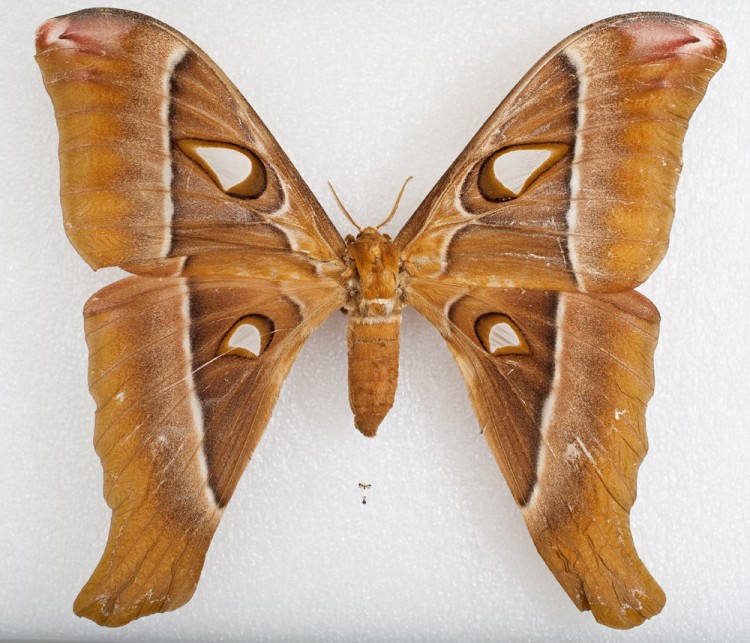

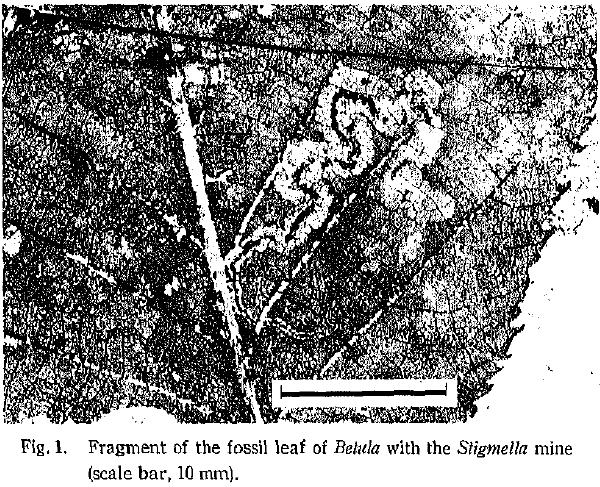

אינטערעסאנט!
I will give these critters a go when the season starts. As a dipterist specializing in the Psychodidae, the Nepticulids’ size range is slightly above what I am usually working with. I suspect that I can make the transition rather rapidly if I just modify my current methods slightly…
Happy to encourage someone to start working with leps! I think the scales on the microleps are more sensitive than would be on a Psychodidae, but I do know how delicate those wings are on the flies so they might not be that far apart after all.
There are numerous Nepticuliids in Monterey County, קאַליפאָרניאַ, from the following families (אזוי ווייַט!) Sumac,Barberry,Birch,Pea,Beech,Walnut,
Mallow,Sycamore,Knotweed,Buckthorn,Rose,Willow. Some plants have more than one species. Rosa californica has an Ectoedemia and two Stigmellas. אינטערעסאנט, pretty moths.
קריס,
I am making a video about microlepidoptera moths for school. I would like to use your picture of the microlepidoptera compared to the huge Coscinocera hercules for a video we are making. May I please use it?
דאַנק,
Cesar
זיכער, you’re welcome to use the image for school!
קריס,
Thank you for letting us use your picture we will send you the link to the movie when it’s done.
דאַנק,
Cesar
[…] די טייניאַסט פון מאָטס […]